With the consistent rising demand for blockchain technology, present businesses are shifting to blockchain app development to enhance their business operations. However, before initializing a blockchain development project, it is important to understand the blockchain development costs involved.
A report from Statista suggests that by 2032, the global blockchain technology market will reach a potential of $943 billion with a CAGR of 56.1% during the period of 2024-2032. The increasing demand for blockchain solutions in various sectors is reflected by this notable growth.
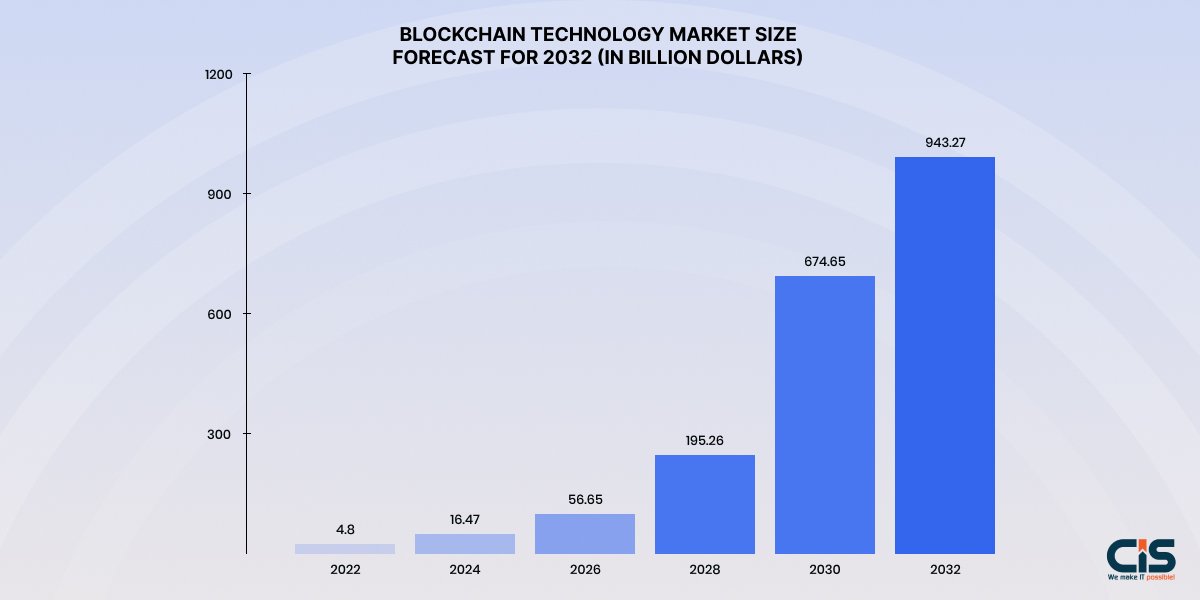
In this article, we will explore the process of budgeting for blockchain development, and provide expert insights on estimating the blockchain application development costs.
What is Blockchain App Development?
Designing applications for blockchain-based platforms, smart contracts, supply chain management systems, hyperledger fabric and other innovative solutions is referred to as blockchain app development. These mobile applications are meant to integrate operations through mobile devices while also ensuring accuracy of data, secure transactions & safe P2P interactions.
Importance of Blockchain in Various Industries:
- Banking and Finance: With blockchain technology, secure and transparent transactions are possible; it also can prevent fraud as well as improve risk management.
- Supply chain: Blockchain improves traceability and transparency, reducing frauds and counterfeits while simultaneously streamlining logistics.
- Healthcare: There is a guarantee for safe patient data management, interoperability and streamlined medical records because of blockchain technology.
- Real estate: Property transactions have been made easy through the use of blockchain which has reduced fraud while offering clear ownership records.
- Government: In an era of block chain revolutionized transparency, corruption is minimized and secure untouchable databases are assured.
Factors Influencing Blockchain App Development Costs
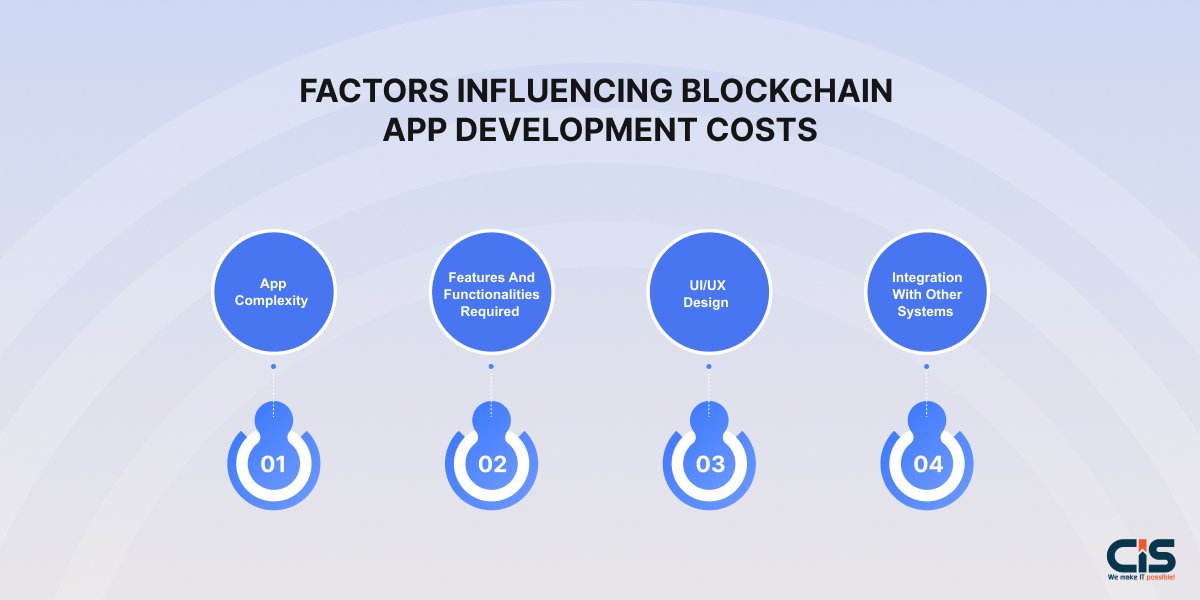
When it comes to app development costs for blockchain projects, there are several factors that need to be taken into account in order to determine the final price. Some of these include:
App Complexity
Blockchain mobile app development cost can be estimated by considering the type of app, development time and technology stack used in the process of developing a blockchain application. The app's complexity is divided into three groups: low, medium, and high.
- Low complexity: These applications offer elementary functionality and straightforward processes. They could contain simple smart contracts or just one use case. They have a small number of users and limited integration requirements.
- Medium complexity: These apps come with abundant features and functionalities. It might involve multiple smart contracts, connection with external systems or complex business logic. Usually they have a moderate amount of users and require higher programming skills.
- High complexity: These applications may have complicated architectures, substantial integration with other systems and advanced functionalities. They might incorporate many smart contracts, sophisticated consensus processes or scalability constraints among others. Often they are used by many customers and demand extensive knowledge in development as well as other technical areas.
When assessing the app development costs for blockchain projects, it is critical to consider a number of aspects that can affect the final price. Here are some important things to bear in mind:
Features and Functionalities Required
The blockchain app you plan to create may sometimes necessitate different features and functionalities depending on the purpose and sector. This will also determine the average cost of developing an application for your mobile devices that use blockchain technology. Some typical features include;
- Smart contracts: These are programmable code that can be embedded in the decentralized ledgers making it easy to carry out financial transactions with them.
- Decentralized finance (DeFi) integration: The blockchain technology allows for DeFi third-party integration, through which people can lend, borrow and perform other financial operations.
- Supply chain management: Goods traceability and transparency is enhanced by these blockchain-based supply chain systems thus reducing counterfeits as well as fraud.
- Identity management: One approach to secure identification management is using a blockchain protocol designed to prevent identity theft or fraud.
- Tokenization: Creating digital assets or tokens on a block chain, which could mean ownership, value or other rights is known as tokenization.
The more complex the features and functionalities required are, the higher the development costs become. Feature selection should consider their criticality and relative impact towards attainment of app objectives on an overall basis.
UI/UX design
Blockchain apps usability and adaptability largely depend on the design of user interface (UI) and user experience (UX). An effectively developed UI/UX boosts user satisfaction, enhances involvement, and raises app success opportunities. Apps need to have a friendly and easy-to-use interface for their users.
Design must be aesthetically pleasing, coherent, as well as aligned with the brand identity of the application. It should support simple navigation through information. According to the purpose or target audience of an application, it can possess different levels of complexity in its UI/UX design. For an extensive UI/UX design, consider the following factors:
- Responsive Design: Cross-platform apps developed using React Native that respond to various devices' screen sizes.
- Clear Presentation of Information: Simple flows for users' intuitive understanding and actions. Use appropriate pictures or graphics as well.
It may take some extra resources but investing in good UI/UX design is indispensable for the success of blockchain apps.
Integration With Other Systems
Blockchain apps often need to integrate with existing systems or other blockchain networks to function effectively. The complexity and effort required for integration can impact the development costs. Integration with other systems may involve:
- External APIs: Integration with external application programming interfaces (APIs) enables the exchange of data and functionality between the blockchain app and external services on a single platform.
- Legacy system integration: Integration with legacy systems may require reverse engineering and adaptation to ensure compatibility and smooth data flow.
- Interoperability with other blockchains: Interoperability allows the blockchain app to interact with other blockchain networks, enabling enhanced functionalities and data sharing.
The integration effort depends on factors like system complexity, documentation availability, APIs, and data format standardization. For low complexity projects, with basic functionalities, simple smart contracts, and a limited number of users, the integration requirements are minimal.
By considering these factors, businesses can estimate app development costs more accurately and plan their budget accordingly. Partnering with a development team and conducting thorough research can help ensure that the estimated cost of app development aligns with the desired outcome.
Also Read: Blockchain Development: What's the Cost? How Much Can You Gain?
Estimating The Cost of Blockchain App Development
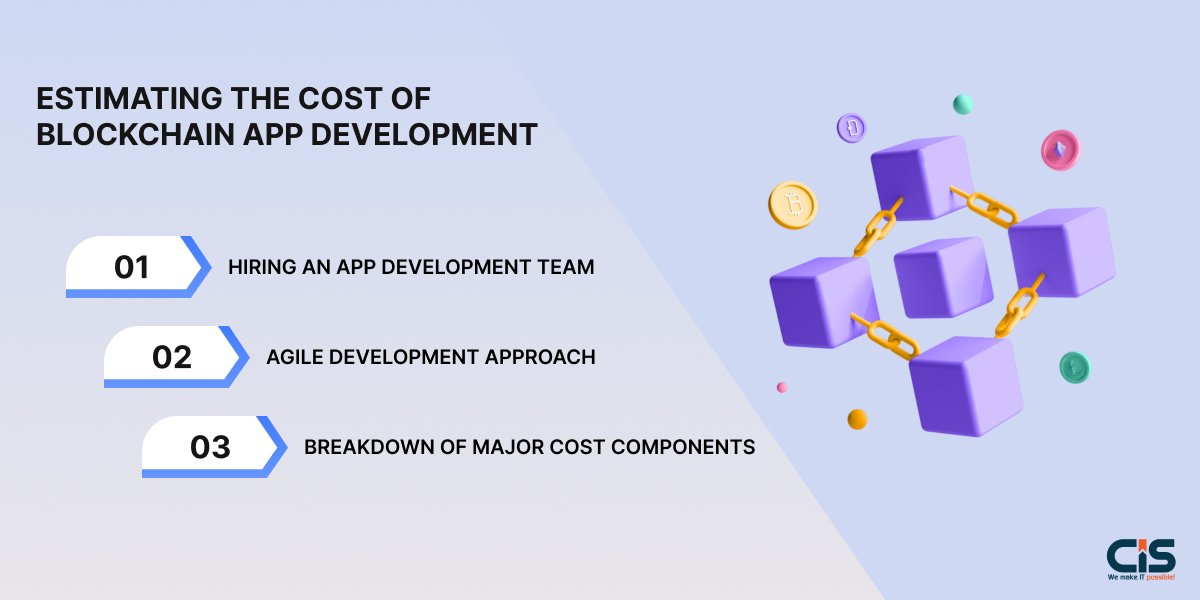
Industry data reveals that the blockchain development costs can vary significantly depending on various factors. To estimate the cost accurately, it is crucial to consider different aspects of the mobile app development process.
Here are some steps to help break down and analyze a rough estimate the cost of blockchain app development:
Hiring an app Development Team:
- According to a recent report, the demand for blockchain developers and professional blockchain app development companies has increased by 517% over the past year.
- To ensure you have the right team, consider factors such as their experience in blockchain app development, proficiency in relevant programming languages, and familiarity with your industry.
- Outsourcing development to countries with lower labor costs, such as India or Ukraine, can also help reduce expenses.
Agile Development Approach:
- Agile development methodologies, such as Scrum or Kanban, have become popular for blockchain app development.
- This approach allows for flexibility and iterative development, enabling quicker time-to-market and cost savings.
- By breaking the project into smaller sprints, it becomes easier to manage and estimate costs.
Breakdown of Major Cost Components:
- Infrastructure costs include setting up and maintaining blockchain nodes or networks. Cloud-based solutions like Google Cloud Platform, Amazon Web Services (AWS) or Microsoft Azure can be cost-effective options.
- Smart contract development requires expertise in languages like Solidity and typically incurs costs for code audits and security reviews.
- UI/UX design costs vary depending on complexity, responsiveness, and aesthetics. It's important to invest in a user-friendly interface that enhances the app's functionality.
- Integration with other systems can range from simple API connections to complex integrations with legacy systems or interoperability with other blockchains.
By taking these factors into account and estimating the costs associated with each component, businesses can create a more accurate budget for their blockchain app development. Collaborating with a reliable blockchain mobile app development company and conducting thorough research will help ensure the estimated costs align with the desired outcome.
Tips for Budgeting for Blockchain App Development
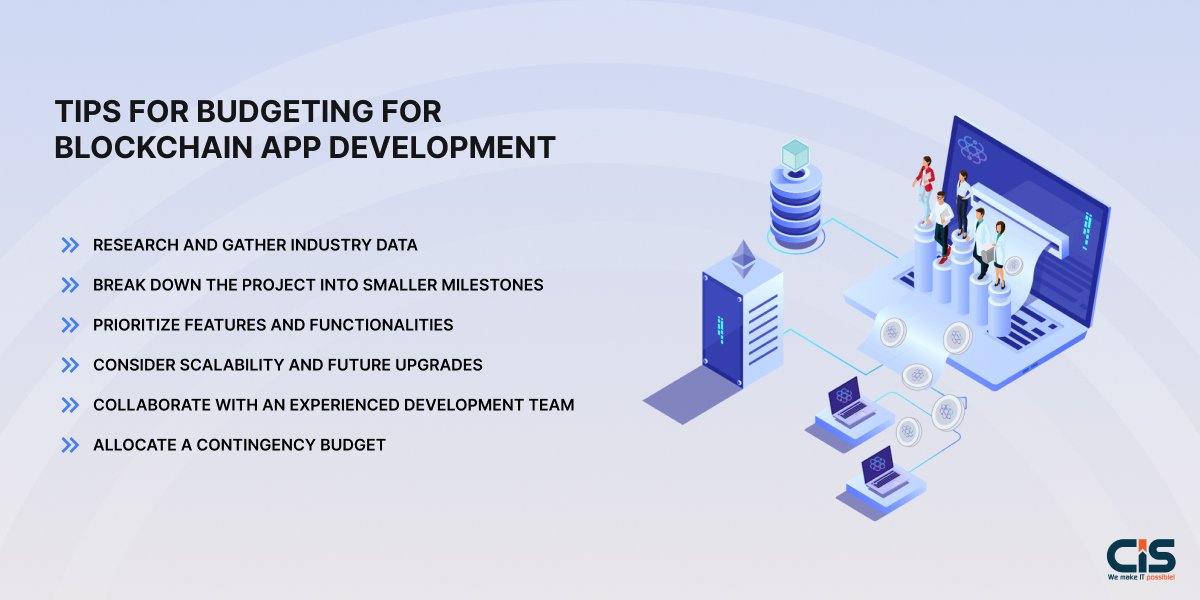
When it comes to budgeting for blockchain app development, there are several key tips to keep in mind. By following these best practices, businesses can ensure they allocate their resources effectively and maximize the return on investment for their app development project. Here are some tips to consider:
- Research and gather industry data: Understand the market trends and costs associated with blockchain app development. Gather industry data and insights to get a clear understanding of what to expect in terms of budgeting.
- Break down the project into smaller milestones: Divide the project into smaller phases or milestones, allowing for better cost estimation and control. This approach will help you allocate resources more efficiently and track the progress of the development.
- Prioritize features and functionalities: Determine the core features and functionalities that are essential for your blockchain app. By prioritizing the top-notch tech stack, you can focus your budget on the most critical aspects and avoid unnecessary expenses.
- Consider scalability and future upgrades: Anticipate future needs and potential scalability requirements. Blockchain technology is constantly evolving, so it's important to allocate resources for future upgrades and enhancements to ensure long-term success.
- Collaborate with an experienced development team: Engaging with a reliable and experienced development team can provide invaluable insights and expertise. Their knowledge of the blockchain industry and app development process can help you make more accurate budget estimations and avoid common pitfalls.
- Allocate a contingency budget: Allocate a buffer budget for unexpected expenses or changes in the project scope to ensure that you have enough resources to handle any unforeseen challenges that may arise during blockchain app development.
By following these tips, businesses can create a budget that aligns with their objectives and maximizes the potential of their blockchain app development project. With thorough research, careful planning, and collaboration with experts, organizations can ensure a successful and cost-effective app development journey.
Detailed Cost Breakdown for a Blockchain Application Development
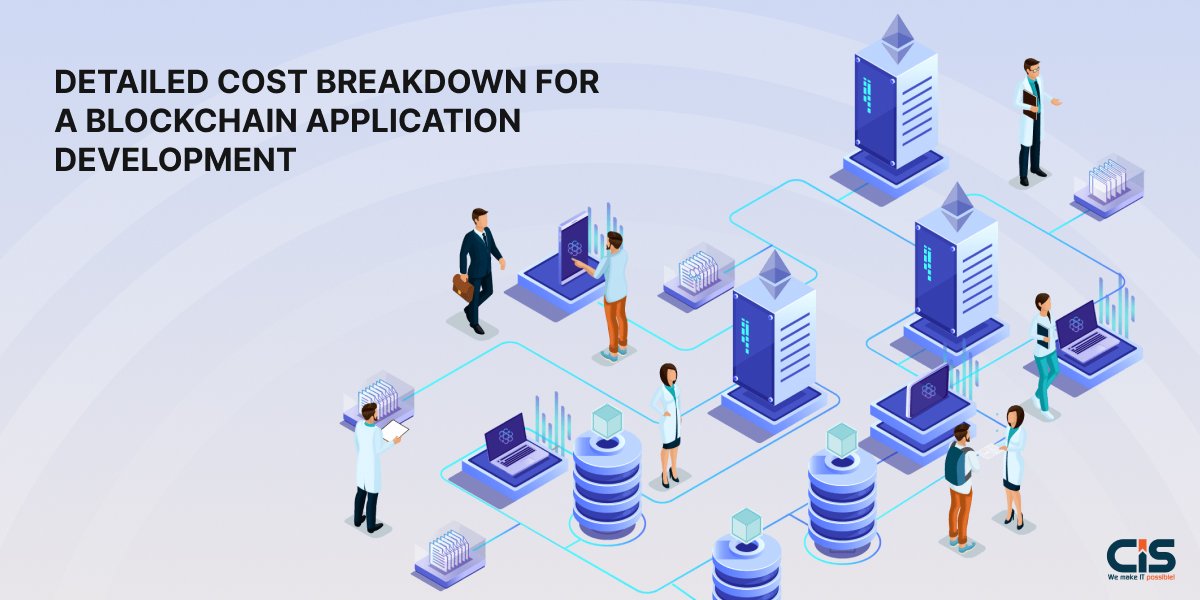
The average cost required for blockchain application development can vary depending on various factors such as complexity, size of the agency, and specific requirements of the complex project.
In this section we will discuss the blockchain app development cost breakdown for simple, moderately complex and highly complex types of apps integrated with blockchain technology.
For a simple blockchain application, the cost can range from $15,000 to $40,000. This includes basic features and functionalities without much complexity. For a simple type of application, you will need to discuss the blockchain app development cost calculator with your development partner. The development partner helps business owners explain whether they cover post launch maintenance and updates for simple types of application.
For a moderately complex blockchain application, the cost can range from $40,000 to $150,000. This includes additional features, integrations, and scalability requirements. These apps can include payment gateways (PayPal or Stripe, Credit or Debit Cards, Apple Pay or Google Pay etc) that assists users to make secure online payments.
For a highly complex blockchain application, the cost can range from $150,000 to $300,000 or more. This model involves third-party services, intricate business models, smart contracts, complex consensus mechanisms, payment gateways and integration with legacy systems or external data sources. You will also get a dedicated project manager along with an expert dedicated team focused on building your blockchain app.
Other than the app development cost based on the complexity of features, you will also need to consider the post-launch app maintenance cost. These ongoing maintenance costs are charged by the development partner to maintain the apps from bug fixes and periodically update your blockchain application and may have huge impacts on development costs.
It is important to consider the size of the blockchain application development company you choose to work with as well. Small cap agencies with up to 50 blockchain developers may offer lower costs for the blockchain app development services compared to medium or large size companies.
Overall, it is essential to carefully assess the requirements of your blockchain project and work closely with a reputable agency to get an accurate cost estimate for your specific needs.
Want More Information About Our Services? Talk to Our Consultants!
The Key Takeaway
In conclusion, budgeting for blockchain app development requires careful research, planning, and collaboration. By understanding industry data and trends, breaking down the project into smaller milestones, and prioritizing core features and functionalities, businesses can create an accurate budget that aligns with their objectives.
It is essential to consider scalability and future upgrades, as blockchain technology continues to evolve rapidly. Collaborating with an experienced development team and allocating a contingency budget can also help mitigate risks and ensure a successful and cost-effective app development journey. By following these tips, businesses can make informed decisions and maximize the potential of their blockchain app development project.
If you are looking to hire an experienced blockchain development company, you should check our blockchain development services. CISIN has 12+ years of experience in developing blockchain applications that provides you the central authority as the business owner, and helps to generate user engagement and achieve your business goals. Contact our expert team of blockchain application developers now.


